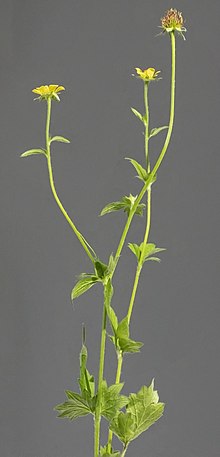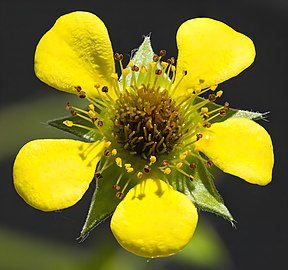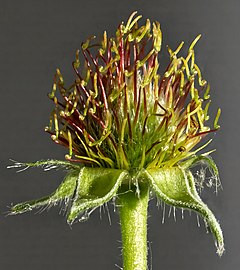Geum urbanum
| Geum urbanum | |
|---|---|

| |
| Scientific classification | |
| Kingdom: | Plantae |
| Clade: | Tracheophytes |
| Clade: | Angiosperms |
| Clade: | Eudicots |
| Clade: | Rosids |
| Order: | Rosales |
| Family: | Rosaceae |
| Genus: | Geum |
| Species: | G. urbanum
|
| Binomial name | |
| Geum urbanum | |
Geum urbanum, also known as wood avens, herb Bennet, colewort and St. Benedict's herb (Latin herba benedicta), is a perennial plant in the rose family (Rosaceae), which grows in shady places (such as woodland edges and near hedgerows) in the temperate regions of Eurasia and North America.
Description
A downy perennial herb with a short thick
The fruiting head consists of many zigzag-shaped hairy achenes measuring 5 - 10 mm long. In fruit, the lower part of each style has a burr that can hook on to the fur of rabbits and other animals for dispersal.[2]
The leaves, which vary considerably in form depending on their position and local growth conditions, are
The stipules, measuring 4 x 3 cm, are as wide as long. [3]
The rhizome is purple in cross section[3]
-
Buds and flower
-
Flower
-
Immature fruit
Distribution
Geum urbanum is found throughout Europe (its areas are more scattered in southern Iberia and in Russia, and it is completely absent from northern Scandinavia, Iceland, the
Etymology and taxonomy
The common name avens is derived from the Latin Avencia, in turn from the medieval Latin avantia or avence. The other English name Herb Bennet is a corrupt translation of the old herbalist name Herba benedicta, meaning blessed herb.
The generic name Geum originated from the Greek geno, a word meaning to yield a pleasant aroma in reference to the root’s strong clove-like smell when freshly dug up.
Geum urbanum hybridizes fairly regularly with Geum rivale (water avens), as they are closely related and cooccur. In fact, the phenomenon is so conspicuous that hybrids were once treated as a separate species named Geum intermedium Ehrh.
It has been introduced in North America,[8][9] where it forms natural hybrids with Geum canadense (= Geum ×catlingii J.-P. Bernard & R. Gauthier).[10]
Both G. urbanum and its hybrids show
Ecology
G. urbanum is a common, typically lowland plant favouring dry semi-natural
It has short rhizomes that support production of flowering stems and potentially viable
G. urbanum occurs in a range of woodland and scrub communities, such as Fraxinus excelsior – Acer campestris – Mercurialis perennis – Glechoma hederacea subcommunity (W8) on base-rich soils and the F. excelsior – Sorbus aucuparia – M. perennis community (W9) in the cooler and wetter parts of Britain in the northwest. It occasionally occurs in Alnus glutinosa – Urtica dioica woodland (W6). It is widespread but local in Rubus fruticosus – Holcus lanatus scrub (W24).[15]
G. urbanum has been observed to be infected by various fungal pathogens, including downy mildew species in Peronospora, powdery mildew Sphaerotheca alchemillae, and Ramularia species, of which the latter causes the formation of pale spots on the leaves.[16]
In folklore
In folklore, wood avens is credited with the power to drive away evil spirits, and worn as an
'Where the root is in the house, Satan can do nothing and flies from it, wherefore it is blessed before all other herbs, and if a man carries the root about him no venomous beast can harm him.'[1]
It was associated with
In herbal medicine and other uses
Herbalists use wood avens to treat various diseases,[17] but there is no scientific evidence it has any benefit.
The roots contain the compound
A cordial against the plague was made by boiling the roots in wine. Gerard recommended a 'decoction made in wine against stomach ills and bites of venomous beasts.' Because of its digestive tonic properties, chewing of the root was also recommended for foul breath.[1]
References
- ^ a b c d e f Grieve M. 1931. A Modern Herbal. Available at A Modern Herbal | Avens (botanical.com). (accessed 20/10/2022)
- ISBN 9780723251750
- ^ ISBN 9780956014429
- ISBN 978-951-9108-14-8.
- ^ Meusel, Hermann; Jäger, E.; Weinert, E. (1965). Vergleichende Chorologie der zentraleuropäischen Flora. Vol. [Band I]. Jena: Fischer. K220, T532.
- ISBN 978-3-87429-263-4.
- ISBN 0521366755
- ^ Brouillet, L., F. Coursol, S.J. Meades, M. Favreau, M. Anions, P. Bélisle & P. Desmet. 2010+. VASCAN, the Database of Vascular Plants of Canada. http://data.canadensys.net/vascan/ (consulted on 2018-01-12)
- ^ USDA, NRCS. 2018. The PLANTS Database (http://plants.usda.gov, 12 January 2018). National Plant Data Team, Greensboro, NC 27401-4901 USA.
- ^ Bernard, J.-P. & R. Gauthier. 1986. Observations sur le Geum urbanum L. dans la région de Québec et description de deux hybrides. Le naturaliste canadien 113: 317-324
- ^ Stace CA. 1975. Hybridization and the Flora of the British Isles. Academic Press.
- ^ a b c d e Taylor K. 1997. Geum urbanum L. Journal of Ecology 85: 705 – 720.
- ^ Waldren S, Etherington JR, Davies MS. 1988. Comparative studies of plant growth and distribution in relation to waterlogging. XV. The effect of waterlogging on growths of various populations of and hybrids between Geum rivale L. and Geum urbanum L. New Phytologist 109: 97 – 106.
- ^ Grime GP, Hodgson JG, Hunt R. 1988. Comparative Plant Ecology, a functional Approach to common British Species. Unwin Hyman, London.
- ^ Rodwell JS. 1991. British Plant Communities: Volume 1, Woodlands and Scrub. Cambridge University Press.
- ^ Ellis MB, Ellis JP. 1985. Microfungi on Land Plants: An Identification Handbook. Croom Helm, London
- OCLC 48876592.
- ^ WILD SPICES OF THE UK, Galloway Wild Foods. http://www.gallowaywildfoods.com/wild-spices-of-the-uk/ (consulted on 03/01/2019)
Sources
- Howard, Michael. Traditional Folk Remedies (Century, 1987), pp 99–100.



